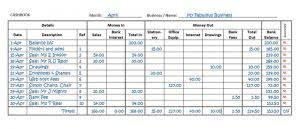Long-Term Debt-to-Total-Assets Ratio: Definition and Formula

Both ratios, however, encompass all of a business’s assets, including tangible assets such as equipment and inventory and intangible assets such as accounts receivables. Because the total debt-to-assets ratio includes more of a company’s liabilities, this number is almost always higher than a company’s long-term debt to assets ratio. Total debt to asset ratio is used debt to asset ratio to assess the solvency and risk of a business. It is calculated by dividing the total liabilities of a business by its total assets. Generally, if the ratio exceeds 40%, it may be an indication of serious financial trouble for the business. Interpreting the debt to assets ratio involves understanding the proportion of a company’s assets that are financed by debt.
- By growing assets, a company can dilute the impact of debt and improve its debt to assets ratio.
- This will determine whether additional loans will be extended to the firm.
- After the amounts have been placed in their appropriate spots in the formula, one can go ahead and calculate the company’s debt-to-asset ratio.
- In other words, it defines the total amount of debt relative to assets owned by the company.
- The two numbers can be very similar, as total assets are equal to total liabilities plus total shareholder’ equity.
- The total-debt-to-total-assets ratio compares the total amount of liabilities of a company to all of its assets.
Finally, if we assume that the company will not default over the next year, then debt due sooner shouldn’t be a concern. In contrast, a company’s ability to service long-term debt will depend on its long-term business prospects, which are less certain. We can see below that for the fiscal year (FY) ended 2017, Apple had total liabilities of $241 billion (rounded) and total shareholders’ equity of $134 billion, according to the company’s 10-K statement. It simply indicates that the company has decided to prioritize raising money through investors instead of taking on debt from banks. A fraction below 0.5 means that a greater portion of the assets is funded by equity.
Example of D/E Ratio
While the total debt to total assets ratio includes all debts, the long-term debt to assets ratio only takes into account long-term debts. The debt to assets ratio is a financial metric that measures the proportion of a company’s total assets financed by debt. It provides insights into how much of a company’s assets are funded by creditors and serves as an indicator of its financial stability. The term debt ratio refers to a financial ratio that measures the extent of a company’s leverage.
You’ll be looking for total assets and total liabilities, both current and non-current. A company with a debt to asset ratio of 40% or below is considered to be financially healthy since it suggests that the business is able to cover its liabilities with its assets. A debt to asset ratio of above 40% can not only hurt the business’s creditworthiness but also its ability to access funds for investments.
What Is the Debt-To-Capital Ratio?
All such information is provided solely for convenience purposes only and all users thereof should be guided accordingly. On the opposite end, Company C seems to be the riskiest, as the carrying value of its debt is double the value of its assets. Pete Rathburn is a copy editor and fact-checker with expertise in economics and personal finance and over twenty years of experience in the classroom. Understanding each company’s size, sector, and goal is pertinent to interpreting its ratio. For example, a company might determine that ceasing to offer a particular product or service would be in their best long-term interest. Adam Hayes, Ph.D., CFA, is a financial writer with 15+ years Wall Street experience as a derivatives trader.
Companies with a high ratio are more leveraged, which increases the risk of default. The debt to asset ratio shows what percentage of the company’s assets are funded by debt, as opposed to equity. For example, in the example above, Hertz is reporting $2.9 billion of intangible assets, $611 million of PPE, and $1.04 billion of goodwill as part of its total $20.9 billion of assets. Therefore, the company has more debt on its books than all of its current assets. Should all of its debts be called immediately by lenders, the company would be unable to pay all its debt, even if the total-debt-to-total-assets ratio indicates it might be able to. A ratio greater than 1 shows that a considerable portion of the assets is funded by debt.
Comparing Companies
This suggests that the company has less financial risk and a stronger ability to weather economic downturns. However, an extremely low ratio may imply underutilization of debt and missed opportunities for leveraging growth. The debt to assets ratio enables meaningful comparisons between companies in the same industry or sector. By analyzing the ratios of different companies, investors can identify industry trends, compare financial stability, and assess risk levels. This analysis is particularly valuable when making investment decisions or evaluating potential business partners. While the long-term debt to assets ratio only takes into account long-term debts, the total-debt-to-total-assets ratio includes all debts.

This ratio provides a general measure of the long-term financial position of a company, including its ability to meet its financial obligations for outstanding loans. The https://www.bookstime.com/ debt to total assets ratio is an indicator of a company’s financial leverage. It tells you the percentage of a company’s total assets that were financed by creditors.





